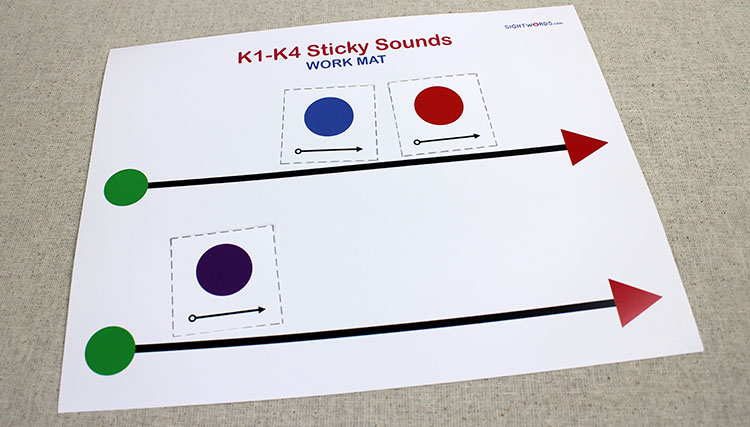K1: Sticky Sounds
1. Overview
Add a consonant sound before an existing consonant sound at the beginning of a two-sound word to make a brand new word. This game focuses on adding a sound to the beginning of a two-sound word to make a three-sound word with a consonant blend.
K1: Sticky Sounds
2. Materials
- Script
- sound counting markers — you only need three of the markers for this game
- work mat
- word list
3. Activity
Video: How to play Sticky Sounds
Start out by explaining the concept of the game to your child.
Adult: You’ve already learned how to count the sounds in a word and put those sounds in the order that you hear them. Now you’re going to listen carefully to the beginning sounds of a word. I’m going to show you how to stick another sound onto the beginning of a word and say the sounds fast to make a longer word.Put the sound counting markers and the work mat in front of the child. She will use these to count the sounds in the words of this activity. Remind her that we read words from left (the green circle, as in “go”) to right (the red triangle at the end of the arrow, as in “stop”). Have her use her index finger to trace the arrow from the green circle to the red triangle.
Adult: Use these markers to show me the sounds in the word I say. Listen carefully: low. “The man spoke in a low voice.” Say low. What word? Child: Low. Adult: Yes. Say the sounds in low, and put a marker on the mat for each sound you say. Start here. [Point to the green circle on the top arrow.] Child: /lll/ [places 1st marker]… /ōōō/ [places 2nd marker] Adult: Good job. You placed the two sound markers in just the right order to make the word low.Now tell the child how to count the sounds in a second word by putting sound counting markers on the second arrow of the work mat.
Adult: I’m going to say another word, and you’re going to count the sounds again. If you hear a sound that you already used to make the word low, move that sound marker down from the top line to the bottom line. What was the first word? Child: Low. Adult: Yes. Here’s my new word. Listen: slow. “Snails are very slow animals.” What word? Child: Slow. Adult: Do you hear a new sound in slow that you don’t hear in low? Listen: ssslllōōō • • lllōōō. Again: ssslllōōō • • lllōōō. Child: Yes, there’s a /sss/ sound! Adult: Is it at the beginning or the end of slow? Say slow and tell me where you hear the /sss/ sound. Child: Slow … at the beginning! Adult: Put a marker for /sss/ at the start of the bottom line on the mat. Now say all the sounds in slow and put them in order on the mat. Remember, if you need a sound marker that you already used for a sound in low, pick up the marker from the top line and move it to the right place on the bottom line. Child: /lll/ … I used that in low, so I move this marker down here next to /sss/. Adult: Okay. What sound markers do you have so far for slow? Child: This one is /sss/, and this one is /lll/. Adult: What sound do you still need to make slow? Say the word and figure it out. Child: sss-lll-ōōō … I need /ōōō/! Adult: Did you use the /ōōō/ marker for one of the sounds in low? Child: Yes. So I have to move that marker down to the bottom line. Adult: Good. Now say the sounds in your new word, quickly. See if two of the sounds stick together when you say the word fast. Child: Slow. Slow. Yes! Adult: Which two sounds stick together when you say slow? Ssslll • • ōōō. Child: /sss/ and /lll/Explain that when /sss/ and /lll/ are next to each other in a word, they are “sticky sounds.” They are almost glued together, they are so sticky! Once your child has successfully completed one round of the game, have her remove the sound counting markers from the mat before starting the next round. One session of this game should last 10-15 minutes, with you and your child covering 6-8 word pairs. Repeat these word pairs several times in random order within the session to give your child lots of practice. Be sure she has a good understanding of the use of two “sticky” consonant sounds to make a new word. ↑ Top
4. Confidence Builder
Reduce the number of word pairs in a session, and repeat them randomly three or four times. ↑ Top5. Small Groups (2-5 children)
Lesson Objective: Using markers and a work mat as visual aids, children will hear a two-phoneme (CV) word, use markers to count and order its phonemes, add a consonant phoneme to the beginning of the word, and blend the three phonemes together orally to create a new word with a consonant blend. GELDS (Georgia Early Learning & Development Standards): CLL6.4f (closest standard) Georgia Standards of Excellence: ELAGSEKRF2.e Common Core State Standards: CCSS.ELA-LITERACY.RF.K.2.E Additional Materials:- enough work mats and sound counting markers for each child
- optional: pocket chart (for displaying work mat and counters)
Leave a Reply
